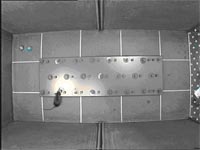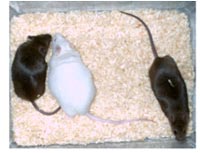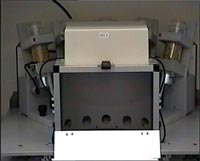Introduction
The goal of the behavioural screen in the German Mouse Clinic (GMC) is the efficient and comprehensive behavioural phenotyping of genetically modified mice with respect to the detection of endophenotypes relevant for human brain dysfunctions, such as anxiety and mood disorders, schizophrenia, attentional and other cognitive deficits, and Parkinson's disease.
Behavioural analysis is set up in a hierarchical way, starting with the primary screen. The behavioural primary screen consists of the modified hole board test, which was specifically developed for effective high-throughput behavioural analysis of lab rodents (2), and offers a comprehensive first overview on locomotor, exploratory, emotional and social behaviour as well as object recognition memory.
However, both brain-specific as well as brain-unspecific kinds of diseases can result in behavioural alterations. Thus, both neurological and psychiatric defects as well as immunological phenotypes can result in parameter changes in our sensitive primary screen. In cases of not centrally mediated behavioural alterations, the role of this project is the contribution to the phenotype description of a mutant line from a behavioural point of view.
For CNS phenotypes within our area of research we offer in depth behavioural analyses, also referred to as secondary and tertiary screens. The secondary behavioural analysis level contains additional well established tests for locomotor, exploratory, emotional and social behaviour (e.g. dark-light transition, elevated plus-maze, open field, social interaction, olfactory perception). Furthermore, at this point functionality of sensorimotor competence and sensorimotor integration are assessed by acoustic startle reflex and pre-pulse inhibition methodology. Results of these analyses will indicate the relevance of the phenotype for anxiety disorders, depression, schizophrenia as well as hearing disorders.
On the tertiary behavioural analysis level various aspects of cognitive performance are being evaluated. The methods used include procedures for the Five choice serial reaction time task (evaluating sustained and divided attention, attentional span and capacity, distractibility), fear-potentiated startle (fear memory, aversive), object recognition memory (appetitive) and social discrimination (social recognition memory, appetitive). In addition, pharmacological challenges are applied if necessary for the clarification of a phenotype.
To be effective, test battery and protocols are optimised and extended if necessary to clarify a phenotype. Therefore, methodological developments are tuned to the demands of interesting mutant mouse lines. Close interaction of the GMC with the EU-funded project EUMORPHIA assures the exchange and availability of latest technological developments and most efficient phenotyping strategies.
In this context, our current research topics are: 1) the development of new, as well as optimisation and standardisation of existing high-throughput tests for behavioural analysis; 2) evaluation of the impact of housing in individually ventilated cages (IVC), which is necessary in large phenotyping facilities for hygienic reasons (1), on behavioural test results as compared to standard housing in conventional cages; 3) investigation of the molecular mechanisms of learning and memory.
Results
With a few modifications adapted to the hygienic and workflow demands of the GMC, the modified Hole Board test has proven a sensitive, reliable and efficient behavioural primary screen in the past 3 years.
Since the start of the GMC 37 mutant mouse lines and six inbred or hybrid lines, respectively, were provided for the primary screen by the Core Facility, which also provided two mutant mouse lines for a secondary screen. Out of the primary screen 18 lines were chosen for further analyses. In eight of these lines we could identify further alterations in behavioural parameters, contributing to the functional analysis of the gene involved.

In-depth behavioural analysis
Concerning methodological developments, we could successfully establish an efficient social discrimination procedure for scoring social recognition memory (3), by the use of ovariectomised females as stimulus animals. In addition, a simple procedure for functional testing of the murine vomeronasal system by using conspecific odours, as well as a simple object recognition procedure were established and validated.
Recently, we were able to further characterize two mutant mouse lines with respect to their behavioural phenotypes.
One of these mutant lines, produced by gene trapping, is behaviourally characterised by an alteration in social behaviour of female mutants. After social deprivation by single housing, wild-type females show an increased social interaction, indicating a social deprivation effect. This effect is absent in male wild-type mice. Female mutants of this line do not exhibit a social deprivation effect after single housing, behaving similar to wild-type males in this respect. The hormonal regulation of these mice, which is assumingly underlying this effect, is currently under investigation.
In the second mutant mouse line, a neuron-specific conditional protein kinase mutant, we found a learning and memory impairment, in both social recognition and object recognition memory. We are currently validating these findings, and these mice will also be characterised by a metabolic screen, since there are indications for altered feeding behaviour.

Standardisation of behavioural phenotyping
After sequencing the human and several other speciesí genome, the determination of gene and protein function is now one of the major challenges in biomedical science. The growing demand for the model organism mouse results not only in an increasing demand for phenotyping facilities to share the workload, but also in an increasing demand for reliable and comparable test results acquired in different laboratories. Thus, large scale mouse functional genomics requires validated and standardised procedures, as minor changes can profoundly affect biological variables, challenging the reproducibility of mouse phenotypic data (4).
Within the integrated EU-project EUMORPHIA, this project has contributed to: 1) the development of a suitable high-throughput primary behavioural test battery targeted to the reliable detection of neurobehavioural phenotypes, including the Open Field Test, a modified SHIRPA protocol, Grip Strength, Accelerating Rotarod, Spontaneous Alternation in the Y-Maze, Prepulse Inhibition, Tail Flick, Tail Suspension and Swim Ability; 2) the development of standard operating protocols (SOPs) for these behavioural tests and 3) the experimental cross-laboratory validation of these SOPs.
The validated SOPs are freely available as part of the European Mouse Phenotyping Resource of Standardised Screens (EMPReSS) under www.eumorphia.org.
Impact of housing conditions
The evaluation of housing condition impact on behavioural test results indicated that IVC housing renders single-housed male mice, both of the C57BL/6J and the C3HeB/FeJ strain, more anxious and less active as compared to conventional non-IVC housing.
We conclude that single housing of male mice of these strains in IVC racks complicates behavioural analysis. In particular, it likely impedes the detection of anxiety-related phenotypes, and our results indicate that this can create problems of various strength depending on the genetic background. It is currently investigated, in both sexes, whether this effect can be compensated for by group housing.
Molecular mechanisms of learning and memory
The interaction of the cannabinoid CB1 receptor with its endogenous ligands plays an essential role in the extinction of aversive memories (5).
To test the generality of this observation with respect to positively-reinforced memories, CB1 receptor mutants and littermate controls were trained in an appetitively-motivated operant conditioning task, in which food-restricted mice received a food reward upon nose-poking into an illuminated hole.
The results of this study demonstrated that the CB1 receptor is not essential for extinction of the stimulus-response association in an appetitively motivated learning task, suggesting a specific role of the CB1 receptor in the extinction of aversive memories (6).

Outlook
As the concept outlined above has proven very successful and the results obtained so far are highly encouraging, our future work will continue in this direction. The focus will be on further understanding of functional mechanisms underlying already detected phenotypes. We will continue to emphasise methodological developments in behavioural analysis, since this strategy proved essential for the progression of functional analysis of phenotypes. Furthermore, this work will contribute to dissect genetic pathways underlying specific behavioural tasks and will provide models for neurological and psychiatric diseases (7).
Additionally, further investigation of the impact of different handling, housing and testing conditions and protocols on behavioural test results will be a vital contribution to the quality of standardised mouse functional genomics.
Lit.: 1. Gailus-Durner V et al. Introducing the German Mouse Clinic: open access platform for standardized phenotyping. Nat Methods. 2005 Jun;2(6):403-4. 2. Ohl F et al. The modified hole board as a differential screen for behaviour in rodents.Behav Res Methods Instrum Comput. 2001 Aug;33(3):392-7. 3. Kogan JH et al. Long-term memory underlying hippocampus-dependent social recognition in mice. Hippocampus. 2000;10(1):47-56. 4. Champy MF et al. Mouse functional genomics requires standardization of mouse handling and housing conditions. Mamm Genome. 2004 Oct;15(10):768-83. 5. Marsicano G et al. The endogenous cannabinoid system controls extinction of aversive memories. Nature. 2002 Aug 1;418(6897):530-4. 6. Hölter SM et al. Cannabinoid CB1 receptor is dispensable for memory extinction in an appetitively-motivated learning task. Eur J Pharmacol. 2005 Mar 7;510(1-2):69-74. 7. Bucan M and T The mouse: genetics meets behaviour. Nat Rev Genet. 2002 Feb;3(2):114-23.


